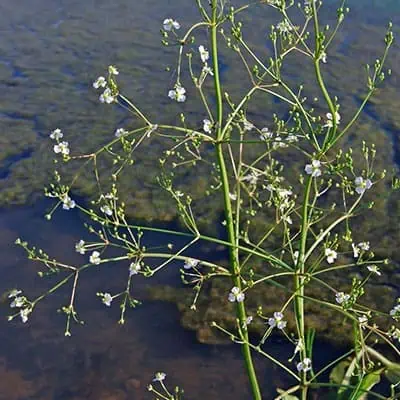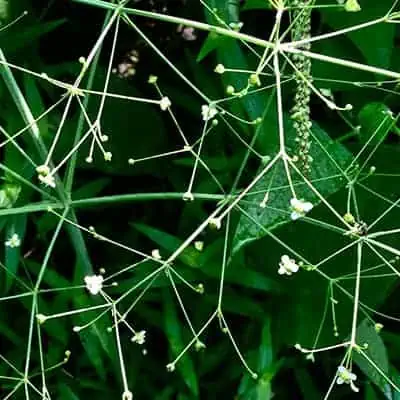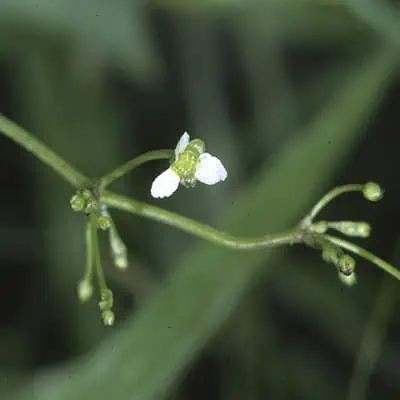
The genus is remarkably hardy and well-adapted, and with over fifty species, Alismas be found on every continent except for Antarctica. Eleven Alisma species are found in the northern hemisphere, with three being recognized as native to North America – Alisma subcordatum, Alisma triviale, and Alisma saggitaria.
Alisma subcordatum loves to have its feet wet, and in the wild can be found all along riverbanks, lakes, and ponds. With a combination of tubers and rhizomatous roots, American water plantain is excellent at filtering water and has been utilized throughout the U.S. to help clean up and restore wetlands and water retention ponds. In addition, it provides nesting and resting spots for helpful macroinvertebrates like caddisflies and alder flies, which in turn provide a valuable food source for fish, turtles, newts, and waterfowl.
The miniature flowers are a useful nectar source for some beetles, flies, and small, harmless Halictid bees. This plant is often damaged by excessive boat use as well as aquatic herbicide use in rivers and shallow lakes, and as such many wild populations are on the decline, though it’s still considered to be a stable species.
American Water Plantain Growth, Hardiness & Climate

Alisma subcordatum is a fast grower, reaching up to three feet in height and over a foot spread over the course of the mild summer months. On land, the basal rosette of broad leaves can reach a foot in height, with the main stem extending another couple of feet and then flowering.
Underwater, leaves are significantly thinner, and will rot over time, leaving only long stems with flowers that float atop the water’s surface or extend above it. Blooming typically occurs from summer through autumn, with each flower living for approximately six hours before dying and dropping off.
Cooler climates are tolerated, but the plants will die back if frosted. Full sun is preferred, but partial shade won’t harm them. In more shaded areas, you may notice that more leaves (and fewer flowers) form if planted above water, as the plant tries to obtain more sunlight. They’re quite hardy plants once established, and don’t require much care beyond ensuring that their roots are kept consistently damp.
How to Plant American Water Plantain In Ponds

In the wild, American water plantain seeds easily on its own, with the seeds overwintering. However, cultivated water plantain is quite difficult to get to grow from seed, as you will have to stimulate the seeds to break their natural dormancy. This can sometimes be achieved by refrigerating damp seeds for several weeks, and then planting them.
Alternatively, you could place seeds beneath the snow in the winter and allow nature to take its course. However, both of these can be tricky and don’t always work, so the easiest method is to plant American water plantain from bare roots.
Bare root plants are dormant from the winter, with no above ground growth, and can simply be placed in the ground as soon as the soil is no longer frozen in the spring and water them thoroughly immediately after planting. Alisma subcordatum is a marginal plant that can be planted either in shallow water or wet soil, but not completely submerged. Thick, loamy, mucky soils are preferred.
How to Care For American Water Plantain

Truly, keeping American water plantain wet should be enough to keep it going strong. As mentioned above, flowers are dropped every few hours during the summer and early autumn, so you’ll need to be vigilant about cleaning them from your pond to maintain water quality.
Despite having rhizomatous roots, water plantain doesn’t spread overly quickly, and as such is unlikely to overtake your pond and you shouldn’t need to trim it back very often. It can form colonies over several years, but again this is usually a slow process and one that can be easily discourage, if desired.
How to Winter American Water Plantain
American water plantain should overwinter just fine on its own outside, resprouting from its fibrous roots and rhizomes in the spring.
Is Water Plantain Toxic, Poisonous or Invasive?
Though water plantains as an overall genus are found worldwide, you should pay close attention to the species. American water plantain, as its name implies, is native to North America and shouldn’t be propagated outside of this region as it may be considered a harmful invasive.
European water plantain (Alisma plantago-aquatica), however, is native throughout much of Europe as well as Eurasia and northern regions of Africa. Due to their slow-growing nature, Alismas don’t often become classified as invasive, but you should still try only to obtain species that are native to your area as introduced species in natural ecosystems can have more far-reaching impacts than often meets the eye.
Alisma subcordatum is not known to be toxic to fish, humans, dogs, cats, or any other organisms as far as research has found.
Is Water Plantain Plant Edible? Will Fish Eat it?
American water plantain is edible, and is often eaten by waterfowl, deer, wild fish species like trout and bass, and some reptiles (primarily turtles) and amphibians (such as newts). People can also eat the roots, as they’re quite high in nutrients and useful carbohydrates.
Some pond fish, like koi, may nibble on roots and leaves but likely not enough to particularly damage the plant, nor will the plant harm your fish if consumed.
Where to Buy Water Plantain & Seeds? (UK & US)
An easily obtainable plant, American water plantain can be found at many pond retailers, plant nurseries, and particularly via online pond and plant outlets.

